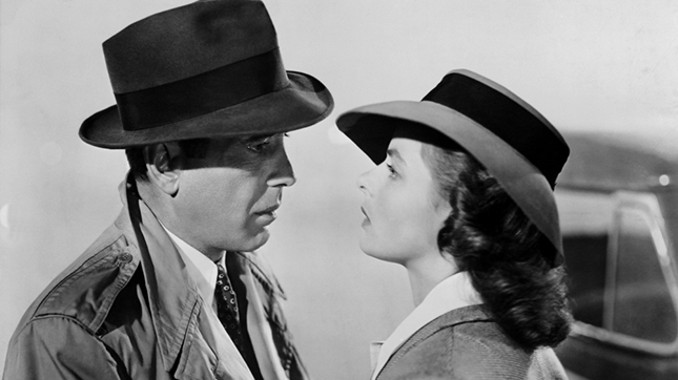Two 1942 movie classics — “Casablanca” and “To Be Or Not To Be” — play at the Stanford Theatre, Friday through Monday, January 13-16.
“To Be Or Not To Be,” master director Ernst Lubitsch’s aggressively black satire on Nazi culture, plays at 7:30pm on all four days, and 3:45pm on Saturday and Sunday.
“Casablanca,” the classic Humphrey Bogart-Ingrid Bergman romance, plays at 5:35pm and 9:20pm, on all four days.
Perhaps you don’t need to be convinced to see “Casablanca” for the umpteenth time. The underrated workhorse director Michael Curtiz directs Bogie and Bergman in their most iconic roles. (Or at least, up there with “The Big Sleep,” “Notorious,” and the Rossellini-Bergman trilogy.) Like “The Godfather” or “The Graduate,” “Casablanca” is a piece of Americana first known, then seen, then seen again. If you haven’t experienced the cosmic electricity of Bogart and Bergman looking out their hotel window (recently referenced in Chazelle’s “La La Land”), please — do so now!
And if you’ve never seen Lubitsch’s “To Be Or Not To Be,” prepare yourself for some of the edgiest and astonishing humor the American cinema ever produced. Time: World War II. Place: Poland. Premise: A troupe of Jewish Shakespearean actors (including surly Carole Lombard and squirrelly Jack Benny) become embroiled in a madcap plot involving the Resistance, Hitler and his goon squad. In order to save the life of a Resistance spy (the dashingly handsome Robert Stack), the Jewish actors must impersonate members of the S.S., including the infamous “Concentration Camp Ehrhardt.” Naturally, shenanigans ensue.
Add to this the fact that America had just entered the European war effort, and you can imagine how the film was received by the press. The New York Times led the anti-art bully pulpit: “Frankly, this corner is unable even remotely to comprehend the humor.”
But time has been kind to Lubitsch’s masterpiece. In the words of the great film critic Andrew Sarris, Lubitsch’s film, though “widely criticized as an inappropriately farcical treatment of Nazi terror,” is able to “bridge the abyss between laughter and terror.” As with Chaplin, whose “The Great Dictator” looks like a puppy compared to the Rottweiler snark and snarl of “To Be Or Not To Be,” Lubitsch realizes the darkness of his material, but refuses to consider comedy an inappropriate way of commenting on the horrors of human lives lost in wartime.
Even today, the laughs are dark, almost uncomfortable — black comedy pushed to its extremes. But Lubitsch’s film is also intelligent, provocative, demands our attention. Its critical eye and vibrant satire—not only of Nazis, but also of the theatre, fascist authority, and the prudish confines of marriage—has rarely been matched. If only today’s comedies could be as daring yet refined as Lubitsch’s Nazi comedy.
Both films screen at the Stanford, as always, in sparkling 35mm.
Contact Carlos Valladares at cvall96 ‘at’ stanford.edu.
Editors’ note: an earlier version of this article inverted the times of the films. “To Be or Not To Be” is the main 7:30 feature, not “Casablanca.” The Daily apologizes for the error.
